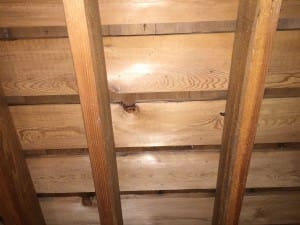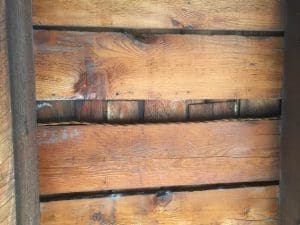This past spring I had a customer tell me they needed a roof but I was the only contractor who had told them that a new roof would require new gutters.

The only way to be sure to know whether a house has had a cedar roof is to look in the attic. Looking at a gable end can be helpful, but it’s no guarantee that you’ll catch whether the roof has cedar or not.
Sometimes we run into situations where the original roof was cedar shake and past homeowners have added additional layers of asphalt shingles over the top of the cedar as a way to save costs. You can tell whether the roof has cedar shake on it by looking in the attic. Between thick gaps in the boards, you can usually see if there was cedar shake.
The way to extend the life of a cedar shake roof is to ventilate it well. Most cedar shake roofs have big gaps between the boards for purposes of ventilation. If the homeowner desires to install an asphalt shingle roof, those gaps have to be filled in so that nails used to hold the shingles on have something to hold the shingles onto the roof. The way most contractors will solve that problem is to put new OSB plywood over the top of the boards.
When the gutters on this style roof were originally put on, there was a piece of metal gutter flashing that sits on the roof decking and hangs down along the fascia. Sometimes, that flashing was part of the original galvanized steel gutter.
When the new OSB plywood gets put onto your roof, it sits on top of that flange. That means that water must drip off of the roof and into the gutter. That’s not a big deal in warm weather climates, but in northern climates where the gutter fills up with water and later ice that will melt in the spring, the OSB on the edge will get saturated if you don’t put new flashing over the top of the OSB.

Most of the time a roof has cedar shake on it you can tell by looking in the attic between the boards. If there’s a vertical line in the wood just past the roof decking, it’s cedar.
These old types of gutters have a flashing flange that is included in the gutter themselves. That flange as well as straps, can’t just be removed and placed on top of the new OSB.
Unfortunately you can’t put a good 3″x 3″ gutter apron that will protect your OSB if the gutters are not removed. This will result in swelling and rot of the OSB.
You as the homeowner must decide if you want to solve a problem, or whether you want to simply go the cheap route.

